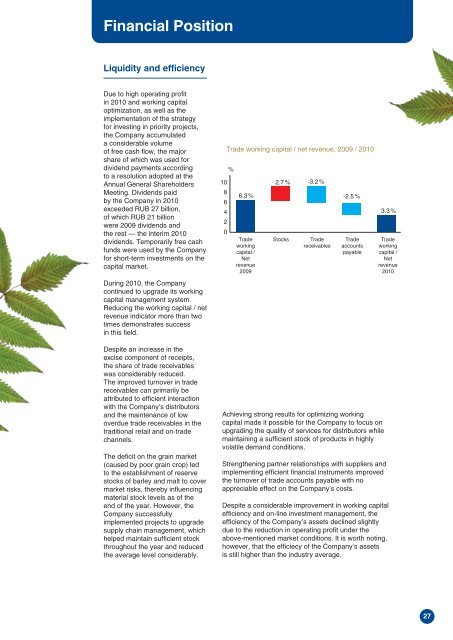Annual Report 2010 - Baltika Breweries
Annual Report 2010 - Baltika Breweries
Annual Report 2010 - Baltika Breweries
You also want an ePaper? Increase the reach of your titles
YUMPU automatically turns print PDFs into web optimized ePapers that Google loves.
Financial Position<br />
Liquidity and efficiency<br />
Due to high operating profit<br />
in <strong>2010</strong> and working capital<br />
optimization, as well as the<br />
implementation of the strategy<br />
for investing in priority projects,<br />
the Company accumulated<br />
a considerable volume<br />
of free cash flow, the major<br />
share of which was used for<br />
dividend payments according<br />
to a resolution adopted at the<br />
<strong>Annual</strong> General Shareholders<br />
Meeting. Dividends paid<br />
by the Company in <strong>2010</strong><br />
exceeded RUB 27 billion,<br />
of which RUB 21 billion<br />
were 2009 dividends and<br />
the rest — the interim <strong>2010</strong><br />
dividends. Temporarily free cash<br />
funds were used by the Company<br />
for short-term investments on the<br />
capital market.<br />
During <strong>2010</strong>, the Company<br />
continued to upgrade its working<br />
capital management system.<br />
Reducing the working capital / net<br />
revenue indicator more than two<br />
times demonstrates success<br />
in this field.<br />
Despite an increase in the<br />
excise component of receipts,<br />
the share of trade receivables<br />
was considerably reduced.<br />
The improved turnover in trade<br />
receivables can primarily be<br />
attributed to efficient interaction<br />
with the Company’s distributors<br />
and the maintenance of low<br />
overdue trade receivables in the<br />
traditional retail and on-trade<br />
channels.<br />
The deficit on the grain market<br />
(caused by poor grain crop) led<br />
to the establishment of reserve<br />
stocks of barley and malt to cover<br />
market risks, thereby influencing<br />
material stock levels as of the<br />
end of the year. However, the<br />
Company successfully<br />
implemented projects to upgrade<br />
supply chain management, which<br />
helped maintain sufficient stock<br />
throughout the year and reduced<br />
the average level considerably.<br />
10<br />
8<br />
6<br />
4<br />
2<br />
0<br />
Trade working capital / net revenue, 2009 / <strong>2010</strong><br />
%<br />
6.3 %<br />
Trade<br />
working<br />
capital /<br />
Net<br />
revenue<br />
2009<br />
2.7 %<br />
-3.2 %<br />
Stocks Trade<br />
receivables<br />
-2.5 %<br />
Trade<br />
accounts<br />
payable<br />
Achieving strong results for optimizing working<br />
capital made it possible for the Company to focus on<br />
upgrading the quality of services for distributors while<br />
maintaining a sufficient stock of products in highly<br />
volatile demand conditions.<br />
Strengthening partner relationships with suppliers and<br />
implementing efficient financial instruments improved<br />
the turnover of trade accounts payable with no<br />
appreciable effect on the Company’s costs.<br />
Despite a considerable improvement in working capital<br />
efficiency and on-line investment management, the<br />
efficiency of the Company’s assets declined slightly<br />
due to the reduction in operating profit under the<br />
above-mentioned market conditions. It is worth noting,<br />
however, that the efficiecy of the Company’s assets<br />
is still higher than the industry average.<br />
3.3 %<br />
Trade<br />
working<br />
capital /<br />
Net<br />
revenue<br />
<strong>2010</strong><br />
27


